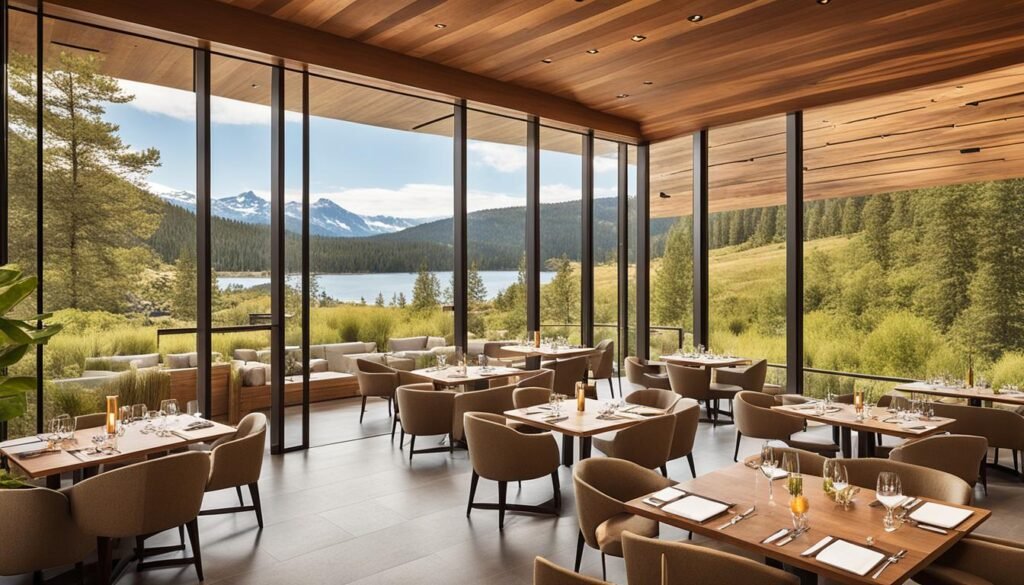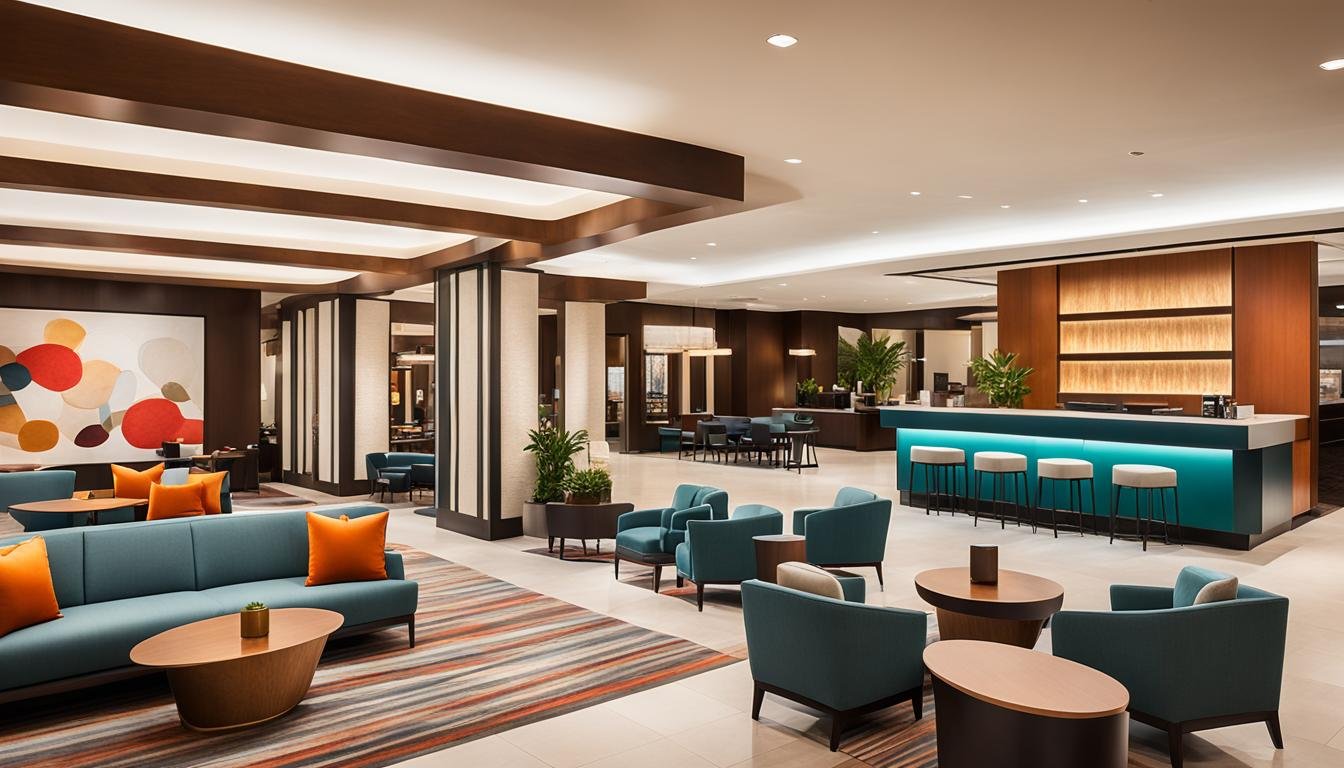Hospitality Interior Design Essentials Guide
Creating a memorable stay is key in the hospitality world. The interior design is pivotal from the lobby to the rooms. It must not only look good but also meet the audience’s needs.
A story can show why interior design matters so much. Imagine you’re tired, checking into a hotel room. But, the room is messy and not cozy. You feel frustrated instead of relaxed.
This story points out why learning about design is crucial. A good hotel design comforts guests right away. A mix of style, local touches, and practicality is key for a good experience.
In this guide, we’ll see what hotel interior design really needs. It’s about focusing on design, understanding color, local culture, and being sustainable. Professional design benefits hotels a lot.
Key Takeaways:
- Understanding the basics of hospitality interior design is crucial for creating a positive guest experience.
- Incorporating interior design principles ensures a visually-appealing and functional space.
- Design focus helps convey the hotel’s brand promise and cater to the target audience.
- The psychology of color plays a significant role in setting the desired atmosphere.
- Balancing form and function ensures that hotel spaces are both aesthetically pleasing and practical.
Why Hotel Interior Design Matters
The interior design of a hotel is vital for success. It does more than look pretty. It draws in the people the hotel wants, shows off what it offers, and makes it stand out. This makes guests remember their stay, impresses event planners, and even gets noticed by locals.
A well-designed hotel draws in its intended guests. When the inside matches what the guests like, they are more likely to stay. So, a boutique hotel might pick bold, modern styles, while a resort might go for timeless elegance. This first look sets the stage for a good guest experience.
The design also shows off the hotel’s best parts. It points guests toward amazing spas, top restaurants, cool rooftop bars, and fancy gyms. This way, guests are encouraged to try these places out and enjoy themselves.
With so many places to choose from, being different is key. Good design makes a hotel memorable. It makes guests want to come back and pick this hotel over others.
“Hotel interior design is not just about creating a beautiful space; it’s about telling a story and invoking emotions. It’s about creating an experience that guests won’t find anywhere else.” – Michelle Brown, Interior Designer
The look and feel of a place say a lot about it. This is true for hotels too. A hotel’s design should tell its own special story and make guests feel a certain way. Everything from colors to furniture should fit the hotel’s brand and leave an impression.
| Benefits of Hotel Interior Design |
|---|
| Attracts targeted guests |
| Showcases hotel amenities |
| Stands out from the competition |
| Inspires event planners |
| Gains recognition from the local community |
To sum up, hotel interior design is a big part of its success. It’s crucial for more than just looks. It pulls in the right guests, shows off what the hotel can do, and makes it stand out. It also tells the hotel’s unique story and gets noticed. Investing in great design pays off in more ways than one.
Hotel Interior Design Tips for Finding Focus
Creating a clear focus in hotel interior design is crucial. It’s about knowing your guests and showing your brand’s promise in a beautiful way — something skilled architects and designers excel at. A design that guests connect with makes their stay memorable.
Let’s dive into expert advice and see examples that nail design focus.
Understanding Your Target Audience
Start by knowing your guests really well. Think about who they are and what they like. For example, do they want a modern, no-fuss vibe or a homey feel? This understanding helps you design the space just right for them. It ensures they’ll have a great time and remember their stay.
Delivering the Brand Promise
The hotel’s look should match what your brand stands for. It’s about offering the upscale or trendy experience as promised. Making sure the design speaks your brand’s language draws guests in. It’s all about creating a space that feels true to what your brand is about.
Creating a Cohesive Design Concept
A good design brings everything in the hotel together harmoniously. The colors, the furniture, the lights, and more all need to work in sync. This unity sets the mood. For instance, a simple, modern design brings peace, while a lively design adds a dose of fun.
“A successful hotel interior design is one that captures the essence of the brand and resonates with the target audience. Every element should contribute to the overall concept, creating a space that is visually stunning and functional.”
– John Smith, Hotel Interior Designer
Take Hotel de Nell in Paris as an excellent focus example. It’s all about elegance in a simple, beautiful way. The mix of soft colors, nature’s touch, and elegant but subtle furniture is the perfect peaceful escape.
In summary, making hotel interiors stand out requires a focused approach. It’s about knowing your guests, staying true to your brand, and designing everything to match. Next, let’s look at how color psychology impacts guest experiences. We’ll explore how different colors make guests feel.
Using Color Psychology in Hotel Interior Design
Colors affect our emotions and perceptions more than we might think. In hotel interior design, the right colors can set the mood, stir certain feelings, and improve how guests feel. We’ll look at how colors play a big role in creating the perfect environment in hotels.
Creating a Relaxing Atmosphere with Cool Colors
Blues, greens, and purples are known to have a calming effect. These cool colors are a great choice for places where guests want to relax, like bedrooms and spas. They bring feelings of peace, quiet, and a cozy vibe. For instance, adding shades of blue in a hotel room can make guests feel calm and relax, especially after a long day on the road or at work.
Stimulating Conversation with Accents of Yellow
To make your space fun and chatty, think about using touches of yellow. It’s a bright, joyful color that gets people talking and in a good mood. You can put yellow in areas where guests gather, like lobbies, lounges, and bars. A little bit of yellow adds energy and a friendly touch to any spot.
“Colors have a tremendous impact on our emotions and can greatly influence our perception of a space.”
Conveying Sophistication and Luxury with Purple
Purple symbolizes luxury, nobility, and elegance. In hotels, using shades of purple can give a high-end, classy feel. You might see this in fancy dining places, upscale lounges, or special suites. Adding purple can make guests feel like they’re in a very deluxe and memorable place.
Creating an Airy Atmosphere with Light Colors
Light colors, like whites and soft pastels, can make a room feel open and breezy. They’re great for small rooms or places with not much natural light. Things like light walls, furniture, and beddings bounce light around, making the space seem bigger and fresher.
Adding Intimacy with Dark Colors
Deep blues, rich browns, and charcoal grays bring a cozy, intimate feel. These dark colors work well in small eating spots, bars, and private hangouts. Used the right way, they can give a sense of comfort and relaxation, inviting guests to unwind.
Now, we’ve learned how colors can be meaningful in hotel interior design. Next, we’ll see some real-life examples. These show how colors can be smartly used to make hotels inviting and unforgettable:
| Hotel | Color Scheme | Effect |
|---|---|---|
| Corinthia London | Blues and neutrals | Creates a serene and sophisticated atmosphere |
| Hotel Indigo | Bright yellows and vibrant accents | Encourages social interaction and a lively ambiance |
| Four Seasons Hotel New York | Rich purples and gold accents | Elevates the feeling of luxury and elegance |
These examples highlight how color design can be key in making hotels stand out. By understanding the emotional effects of colors, designers can choose the perfect shades. This helps in creating the right vibe and brand image for the hotel.
Balancing Form and Function in Hotel Interior Design
Hotel interior design must balance looks with practicality. While it’s important to be pretty, the design must work well too. This rule is extra crucial for guest rooms and common areas that shape the guest experience.
Designing Guest Rooms for Usability
Guest rooms need to be easy and convenient to use. Everything, from lights to TV systems, should be simple to operate. Hotels should include clear instructions so guests enjoy their stay. This focus on usability makes the place both welcoming and memorable.
Comfortable and Accessible Public Spaces
Public areas need to be comfy and easy to get around. Having enough seats, right lighting, and good signs improves guest visits. Hotels aim for spaces that feel welcoming and let people move around freely. This balance of looks and use ensures guests have a great time.
Durable Flooring for High-Traffic Areas
Places like hallways and lobbies need strong floors. With lots of people walking, the materials must last but still look good. Hardwood, luxury vinyl, or carpet tiles work well because they’re tough and easy to take care of. Sturdy floors help hotels keep their look for a long time.
“Hotel interior design should never compromise functionality for the sake of aesthetics. It is essential to prioritize usability and convenience to create a seamless experience for guests.” – Jenna Smith, Interior Design Expert
In a nutshell, a good hotel design must marry style with usefulness. Create guest rooms that are easy to use, design public spaces that are inviting and easy to move around in, and pick long-lasting flooring options. Thinking about how guests will interact with every part of the design ensures a great experience.
| Functionality in Hotel Design | Designing Guest Rooms for Usability |
|---|---|
| Prioritize usability and convenience | Provide clear instructions and intuitive features |
| Create comfortable and accessible public spaces | Focus on comfort and ease of navigation |
| Choose durable flooring for high-traffic areas | Opt for materials that can withstand wear and tear |
Incorporating Local Culture into Hotel Interior Design
Designing hotel spaces involves making guests feel at home while immersing them in local flavors. This means adding local elements that make the stay unique. These touches highlight the destination’s allure.
Local art is a great way to do this. It not only brightens up the place but also backs community artists. From paintings to sculptures, it gives guests a peek into the area’s art scene.
“We believe that incorporating local art into our hotel design is essential to creating an authentic experience for our guests. It allows them to connect with the local culture and enhances their overall stay.” – Jennifer Sanchez, Interior Designer
Architectural details can also show off a place’s spirit. Think using materials found nearby or adding local design motifs. This not only makes the setting special but honors its past and style.
By mixing these local elements just right, designers craft a place that truly mirrors its surroundings. This makes for a stay that tourists will cherish.
Blending in with the Surroundings in Hotel Interior Design

Hotels can blend in with the environment by design, bridging the indoors and outdoors. This approach lets guests fully experience the surroundings, indoors. With elements from nature and the local area, hotels create a special vibe. It mirrors the natural beauty in their surroundings.
Big windows are key in merging a hotel’s insides with the outside. They provide stunning views and flood the area with light. Take the Bulgari Resort in Dubai as an example. It has floor-to-ceiling windows, offering unforgettable sights of the Arabian Gulf.
Having open lobbies also helps connect inside with outside. Outdoor seating, water features, and plants welcome guests. The sound of water and rustling leaves make the place feel calm. It adds to the guest’s joy.
“Hotel designs that fit in with their setting link indoor and outdoor spaces smoothly. They make guests feel close to nature while enjoying luxury comforts of a hotel.”
Using natural materials inside also helps. Things like reclaimed wood and stone bring a touch of the area’s culture inside. They look great and make the space feel cozy. This creates a connection with the hotel’s surroundings.
Mixing indoor and outdoor areas thoughtfully makes the hotel’s design feel one with nature. This way, guests can enjoy nature’s beauty while staying in comfort. It makes their stay unforgettable. This approach is great for both the guest and the environment around the hotel.
The Importance of Lighting in Hotel Interior Design
Lighting is key in making hotels feel welcoming and captivating. It doesn’t just help us see; it also boosts the hotel’s design and mood. Good lighting makes guests feel at ease and part of the hotel’s unique world.
The role of lighting in hotels is huge. It sets the vibe, shows off the building’s best parts, and makes the space look great. Both natural and artificial light are essential. Each type enhances the hotel’s design in its own way.
Functional and Aesthetic Lighting
Hotel lighting should look good and help people do things easily. For tasks like reading or working, there’s task lighting. It includes lights next to beds or on desks that focus light where it’s needed.
Aesthetic lighting makes the hotel feel lovely and lively. It includes lights that spread across a room (ambient lighting) and lights that highlight special spots (accent lighting). Fancy lights like chandeliers can make the hotel look elegant and luxurious.
Creating a Memorable Experience
Good lighting can make a big impact on guests. It turns a space into an unforgettable experience. Think about a warmly lit lobby or a restaurant with soft lights. These places stick in our minds because of how they’re lit.
“Lighting is one of the key elements in creating a memorable hotel experience. It sets the tone and reflects the brand identity, whether it’s cozy and intimate or vibrant and energetic.” – Hotel de Nell, Paris
Showcasing Architectural Design and Artwork
Lighting can also show off a hotel’s unique features and art pieces. The right lights point out special parts of the building or artwork. This grabs guests’ attention and wows them.
Accent lighting is perfect for highlighting art and sculptures. By placing lights carefully, hotels can make art and design look more stunning. This creates a wow factor.
Examples of Exceptional Hotel Lighting Design
Corinthia London and The Bulgari Resort are great at using light. The Corinthia has a stunning chandelier in its lobby. It also uses spotlights to showcase beautiful art.
The Bulgari Resort in Dubai connects indoor and outdoor areas beautifully. Big windows and clever lighting blend indoor spaces with the outdoors. It’s an experience in itself.
Lighting’s role in hotel design is huge. It creates atmosphere, shows off design, and impresses guests. By balancing the need for light to see and light to enjoy, hotels can make spaces where everyone feels welcome.
Ensuring Smooth Transitions in Hotel Interior Design
Hotel interior design aims for smooth transitions between areas. This keeps the guest experience unified and comfortable. It’s essential to think about elements like signage and lighting. They help guide guests and ensure they feel comfortable everywhere.
Designing Transitional Spaces with Proper Signage
Signage is key in making sure guests can move through the hotel easily. It gives them important info and a sense of where to go. Here’s what’s vital in signage design:
- Visibility: Make sure signs can be seen clearly, even from far away. Big fonts, bright colors, and the right light help.
- Clarity: Keep messages short and easy to understand with simple language and symbols.
- Consistency: Designing signs the same way everywhere helps guests know what to look for.
When signage is done right, guests will explore the hotel confidently and with less stress.
Optimizing Lighting for Smooth Transitions
Lighting is crucial for blending one hotel area into the next. It sets a mood and helps spaces flow together. Some lighting tips include:
- Ambient Lighting: This type of light makes spaces feel inviting and ensures there are no dark corners.
- Accent Lighting: It spotlights special areas, helping guests know where to go.
- Natural Lighting: Sunlight makes areas feel fresh and connects the indoors with outside spaces.
Combining smart lighting with good signage ensures guests enjoy their visit and remember it well. It continues their great experience from check-in to check-out.
“The design of transitional spaces in hotels should focus on providing a seamless and pleasant experience for guests, making them feel comfortable and confident as they move through the various areas of the property.”
| Benefits of Proper Signage in Hotel Transitions | Importance of Lighting in Hotel Transitions |
|---|---|
|
|
The Benefits of Professional Interior Design in Hotels
Professional interior design is key for effective hotel designs. It ensures they meet all needs. By hiring an interior designer, hotels become appealing and match their brand.
Designers bring lots of skills and knowledge. They make spaces pretty and useful. They use things like space planning and color choices to turn hotels into warm places.
Interior design makes hotels stand out in a tough market. Designers add unique touches that guests remember. This can be through special lights, interesting textures, and art.
Good design is also great for a hotel’s brand. Designers and owners work together to show the hotel’s values. This makes the space feel right for the people they want to visit.
Expert Quote:
“Professional interior design in hotels is more than just selecting furniture and colors. It’s about creating an experience that resonates with guests, from the moment they step into the lobby to the minute they enter their rooms. A well-designed hotel interior sets the tone for the entire stay and leaves a lasting impression.”
– Jane Davis, Award-winning Interior Designer
The Cost-Effectiveness of Professional Interior Design
Some hotel owners worry about the cost of professional design. But, it’s worth it in the long run. An expert can help avoid big design mistakes and save money on space use.
Designers have connections for good deals on materials. They can guide on space use and avoiding big changes. This helps make the hotel more successful in the end.
The Collaborative Process of Professional Interior Design
Hiring an interior designer is a team effort. They work with many people to make the design real. This includes listening to what the client wants and sharing design ideas.
Designers keep everyone updated and manage the project details. This teamwork ensures the hotel’s dream and the design’s beauty meet at the end.
The Impact of Professional Interior Design on Guest Experience
Interior design aims to make guests feel happy and welcome. Hotels, from the lobby to the rooms, should be enjoyable. Every design choice matters for how guests feel.
Guests start forming their opinion of the hotel the moment they arrive. Good design helps make this impression great. It encourages guests to come back and recommend the hotel to others.
| Benefits of Professional Interior Design in Hotels | SEO Keywords |
|---|---|
| Expertise and experience in design principles, trends, and industry standards | Importance of professional interior design |
| Creating cohesive and visually-appealing designs | Hiring an interior designer for hotels |
| Standing out in a competitive market | Importance of professional interior design |
| Aligning with the hotel’s branding and target audience | Hiring an interior designer for hotels |
| Cost-effective design choices and resource optimization | Importance of professional interior design |
| Collaboration with stakeholders to bring the vision to life | Hiring an interior designer for hotels |
| Elevating the guest experience through welcoming and comfortable spaces | Importance of professional interior design |
Incorporating Sustainability in Hotel Interior Design
Sustainability is key in today’s hotel design. People care more about nature’s health. So, using eco-friendly design in hotels is a big focus. It not only helps the earth but also meets the desire for green stays.
To make hotels eco-friendly, designers pick green materials. These should be easy on the earth, like organic fibers, and safe for people. By choosing wisely, hotels tread lightly on the planet and show they care.
The Benefits of Sustainable Hotel Design
Good for nature, sustainable hotels also save money. Efficient lights and systems cut down on bills. Less waste means lower cleanup costs. This all adds up to more cash in the bank.
Guests love staying in hotels that help the planet. Making eco choices draws them in. It’s a win-win for hotels and their visitors.
“Sustainable hotel design not only benefits the environment, but also appeals to the growing demand for eco-friendly accommodations.”
Being green is great for a hotel’s image, too. Showing care for nature boosts its appeal. It tells customers the hotel shares their values. This builds a loyal fanbase.
Incorporating Sustainability in Hotel Interior Design: Best Practices
There are lots of smart ways to design hotels with nature in mind:
- Letting in lots of daylight cuts down on using lights. This saves power. Plus, it makes the space feel open and inviting.
- Modern lighting and smart sensors drop energy use. This is good for the environment and the budget.
- Getting power from the sun or earth means cleaner energy. It’s a big step towards a greener operation.
- Being smart with water saves a precious resource. Low-flow items and water recycling help make every drop count.
- Getting local art and furniture supports the nearby community. It also cuts down on pollution from shipping goods.
Using these tips helps make hotels not just look good but do good. It’s more than a fad; it’s essential for a brighter tomorrow.
Conclusion
Hotel interior design is key for a great guest stay and a unique brand look. Designers focus on the people visiting, add local touches, and blend beauty with practicality. They also keep an eye on what’s new in design.
By working with experts, hotels make designs that wow. These choices help a hotel shine against its rivals. Great design means guests are happy and keep coming back, making the hotel a top choice.
FAQ
Q: What is the significance of hotel interior design?
Q: How does hotel interior design benefit hotels?
Q: How can I find focus when designing a hotel interior?
Q: What role do colors play in hotel interior design?
Q: How can functionality be balanced with aesthetics in hotel interior design?
Q: How can I incorporate local elements into hotel interiors?
Q: How can hotel designs blend with their surroundings?
Q: How important is lighting in hotel interior design?
Q: How can smooth transitions be ensured in hotel interior design?
Q: Why is professional interior design important for hotels?
Q: How can sustainability be incorporated into hotel interior design?
Source Links
- https://www.cvent.com/en/blog/hospitality/hotel-interior-design
- https://www.linkedin.com/pulse/hospitality-interior-design-everything-
- https://www.designstudio210.com/business/hotel-interior-design-tips/







